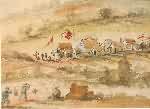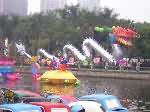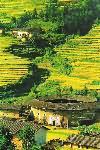- Getting around Lijiang. Dont stay in the Old Towns more than 2 days, there is nothing to do. KRISS Oct 9, 2013 05:46
- 2013 Beijing Temple Fair BENNYLAU Feb 26, 2013 03:29
- Malaysian traveling from KUL - LAX vis Shanghai PVG ZATI_DY Jan 3, 2013 20:15
Ahoy Amoy
- Views: 37802
- |Vote: 1 0
- |Add to Favorites
- |Recommend to Friends
The Treaty Port
Formerly known as Amoy, Xiamen was one of the earliest treaty ports opened to foreigners in 1842 by the signing of the Nanjing Treaty just after the first ‘Opium War’ with Britain. Amoy had been trading with the Portuguese way back in the 16th century but was eventually closed to foreigners in 1750. Although the city dates back many centuries it was during the Ming Dynasty that it was established as a seaport and a commercial center and later became a haven for the Ming court fleeing the Manchu invasion in the 17th century. The Japanese occupied Xiamen from 1938 until the end of the war.
Xiamen is essentially a group of islands featuring beautiful granite boulder outcrops in the estuary of Jiulong River and its deep-water harbour on the south coast of China. The best known of these is Gulangyu, also known as ‘Piano Island’ since it is reputed to have over 600 pianos and the island has nurtured some of China’s most celebrated musicians. Visitors who stroll around the narrow streets during the afternoon and evenings will hear the tinkle of ivory almost everywhere. It’s a five-minute ferry ride from Xiamen City, which is located on the larger Xiamen Island, which in turn is joined by a causeway to the mainland in Jimei district and to Haiceng district in the west, by a bridge.
The Colonial Enclave
Gulangyu or ‘Drumming Wave’ island is arguably the most interesting place in Xiamen. It was chosen by the Portuguese, French, British, and Americans to build their business houses, consulates, libraries, churches, hospitals and hotels and some grand private residences with much of this ‘colonial’ influence still visible today. There are no vehicles on the island, the only form of transport other than walking is a small electric tour bus offered to visitors and a chair lift from Sunlight Hill to Hero Hill. One can circumnavigate the island by way of the waterside boardwalk, several tunnels and the narrow twisting lanes that crisscross the island.
I visited the island on two occasions with my friends, one had even taught for several years in the Art College and it seemed strange to me that neither of them knew of all the things to be discovered on this tiny island. Needless to say I will return one day to discover some more of its gems. Today Gulangyu is home to several schools, the Art College, a Piano Museum, a Sea World, two bird sanctuaries, several parks, some great little swimming beaches, tourist resorts, hotels, restaurants and souvenir shops selling everything imaginable from the sea. Dried and salted seafood including shark fin, jellyfish and sea cucumber and accessories and trinkets of coral, shells, sharks teeth and pearls. If it is not edible it is almost certainly wearable.
The Chinese Camp
I also found the small History Museum, in a former consular building on top of Luotuo Hill with magnificent views over the island and the city. But what interested me most were the records of several ships bound for Sydney in the 1840’s and 50’s. More than 12,000 Chinese men and a handful of women sailed south from Amoy into the unknown in a quest for gold and riches during the peak of Victoria’s gold rushes, many of them never to return.
My great grandfather was an adventurous young man and quite an artist. Recently arrived in Australia he had traveled through Victoria’s gold diggings for several months before eventually taking a position in the far north Queensland as Cooktown’s Magistrate and Telegraph officer. Not long before I set out for China and my own unknowns, I had come across a print of one of his paintings, entitled ‘Chinese Camp, Creswick’ 1855 and now here I was reading a passenger list that may well have included some of the very men he had painted in that camp so long ago.
The Bay
The Penghu Island group and the controversial Taiwan Island just across the straits shelter Xiamen city from the South China Sea. It is said that when men first landed on the Xiamen Islands, they found flocks of egrets and the layout of the islands resembled the bird readying for flight. Since then the islands have also been called Egret Islands. The shallow waters, small islands and mangroves of the Jiulong River estuary offer a natural paradise for egrets. Dayu isle has recently been designated as an egret reserve where ten of the twenty species in China can now be found while the egret has become a symbol of Xiamen city.
Xiamen today is a relatively small city with only a remnant of her colonial architecture remaining around Zhongshan Lu district and the waterfront wharfs but it still attracts foreigners to live and work here. I met a group who work in the city and joined them for a beer and a barbeque aboard a local fishing boat that they had hired. We cruised out past Gulangyu to anchor off Jimen Island where we were able to dive and swim off the boat. It was a great way to spend a hot summers day.
The Climate
Trying to avoid the humid summer heat, I left the house early one morning to climb the hill adorned with boulders behind my friend’s house taking their seven-year-old daughter with me. Many of the trees lining the road were indigenous Australian wattles and gums and I felt quite at home as we approached the reservoir nestled near the peak. On the way up we passed some residents out jogging, another was taking a swim and then we came across a group of singers practicing in the quiet of the soft morning light. This small hill gave us a great view of the northern side of the city and some exercise. The next morning we took the low road beyond the reservoir passing through several groves of longan or Dragon Eye fruit trees almost ready for harvest, eventually coming upon a very small village.
Xiamen enjoys a subtropical climate which is hot and wet in summer and mild and dry in winter although it can experience some pretty cold snaps as I was to find on my second visit at the end of the winter but it was cold all over southern China at the time. With such an ideal climate Xiamen prides herself on her parks and gardens and justifiably so. The city tree, while not a native is the magnificent red flowering Royal Poinciana, with a large spreading canopy and buttress roots. A native of tropical Madagascar it’s an ideal shade tree and lines many of Xiamen’s streets and parks adding vibrant colour to this already vibrant city. The more recently developed areas of the city boast broad tree lined boulevards with landscaped medium strips enhancing the cities leisurely holiday atmosphere. A water front esplanade and parkland encircles almost fifty percent of Xiamen Island giving access to many of her beaches, parks, restaurants and resorts.
The Catch of the Day
Xiamen is and has always been an entrepreneurial city and each year in September hosts an International Trade Fair in the new Exhibition Centre near the waterfront in Qi’an. Her deepwater port facilities make her an ideal location for import and export companies to do business and many joint venture and foreign companies have factories and headquarters here.
Being a coastal city, fresh seafood is a specialty and seafood restaurants outdo each other in location, décor and menu presentation. One such example is opposite the Exhibition Centre. This mutli- story building with double glass walls, water cascading between the panes gives the impression of sitting beneath a waterfall. The ‘catch of the day’ is on display in seawater tanks lining the entrance for diners to choose their dishes on the way to the luxurious private dining rooms equipped with TV in case the conversation dries up or the kids need entertainment during dinner.
This is the top of the range in restaurant experiences but you can find anything to suit your budget. On the many occasions we ate out it was almost always seafood and when we dined at home or with friends it was more often than not on fresh fish and shellfish form the markets that we had chosen ourselves shortly before preparing the meal.
The Educational Sights
Xiamen University is quite a famous institution with an enviable waterfront location on the southern coast of the island, overlooking the beach near the Nanputuo Temple at the foot of Taiping Hill. The magnificent Wanshi Botanical Gardens which includes a hothouse of cacti and one of my favourite flowers, the oh so fragrant frangipani sprawls over Taiping Hill rewarding hot thirsty climbers for their effort with fabulous views across the outer harbour to Jimen Island and south over Gulangyu.
Another famous education facility is the Jimei School Village, just off the causeway on the mainland, built in 1913 by Tan Kahkee who made his fortunes in Singapore and returned some of his wealth by investing in the school. Most of the buildings follow Tan’s unique architectural style. It’s a pretty self-contained compound ranging from kindergarten to colleges on the waterfront with narrow streets lined with shady paper bark trees. In Ao Yuan or Turtle Park 653 carvings etched in polished granite panels using a variety of techniques line the walkways. The carvings depict historical events and stories or inscriptions by famous people. You can buy small modern pieces of this art medium but be warned it weighs a ton. The park, comprising a portico, a monument to liberation and Tan’s mausoleum juts out into the bay overlooking Xiamen and fishing boats rest high and dry on the surrounding mud flats at low tide.
No matter where you are in Xiamen you are never for from the sea. Wherever you look around Xiamen you will see lakes, rivers, the sea or the granite boulder strewn hills that surround and protect it. From Xiamen it’s a short distance to two more of southern Fujian’s attractions. Quanzhou to the north is an ancient port on the maritime silk route that Marco Polo once wrote home about and to the west is Yongding and the Hakka peoples facinating ‘rammed earth’ clan strongholds.
For more on Yongding read my Travel Review - Strongholds of the Southern Hakka






 Copyright © 1998-2025 All rights reserved.
Copyright © 1998-2025 All rights reserved.